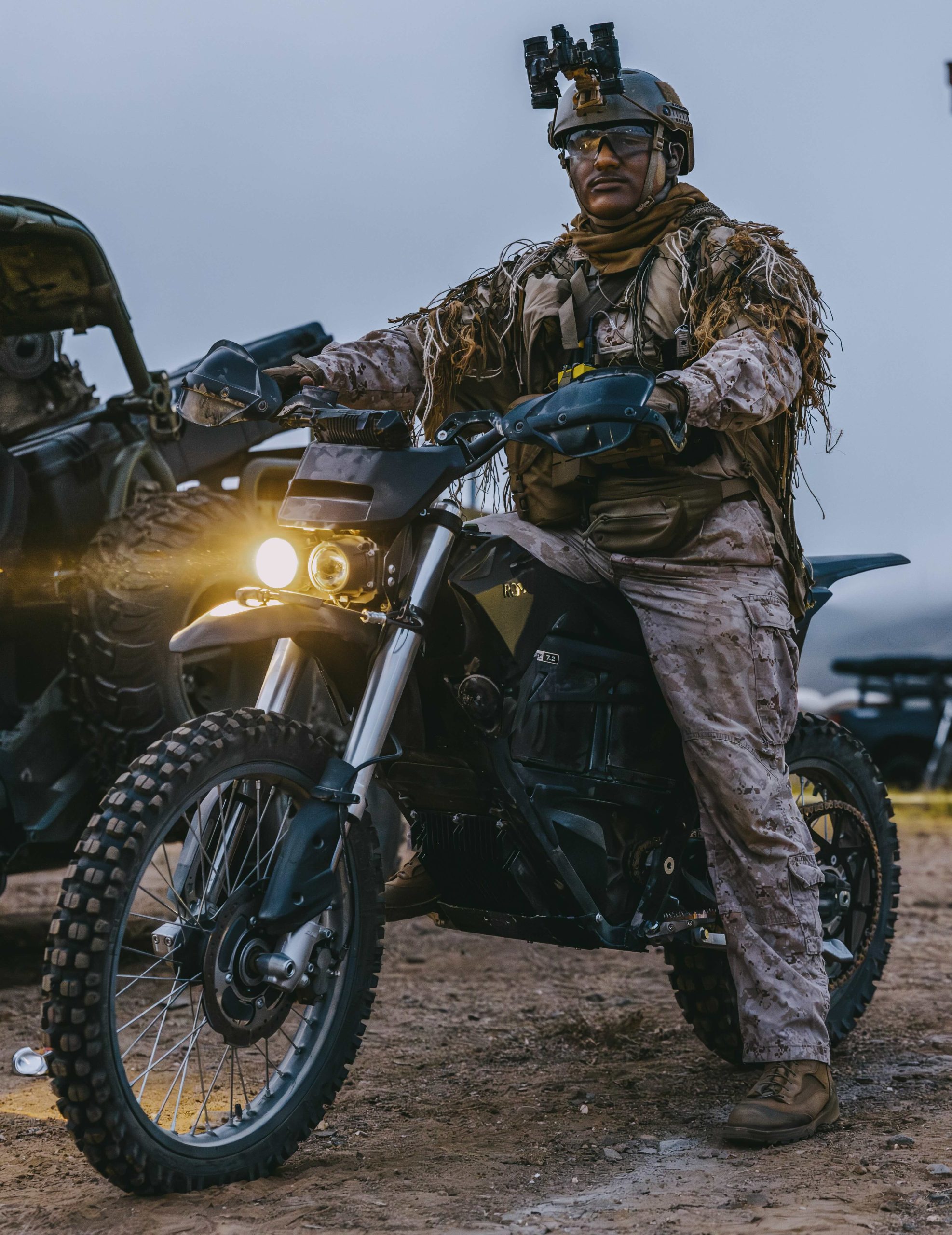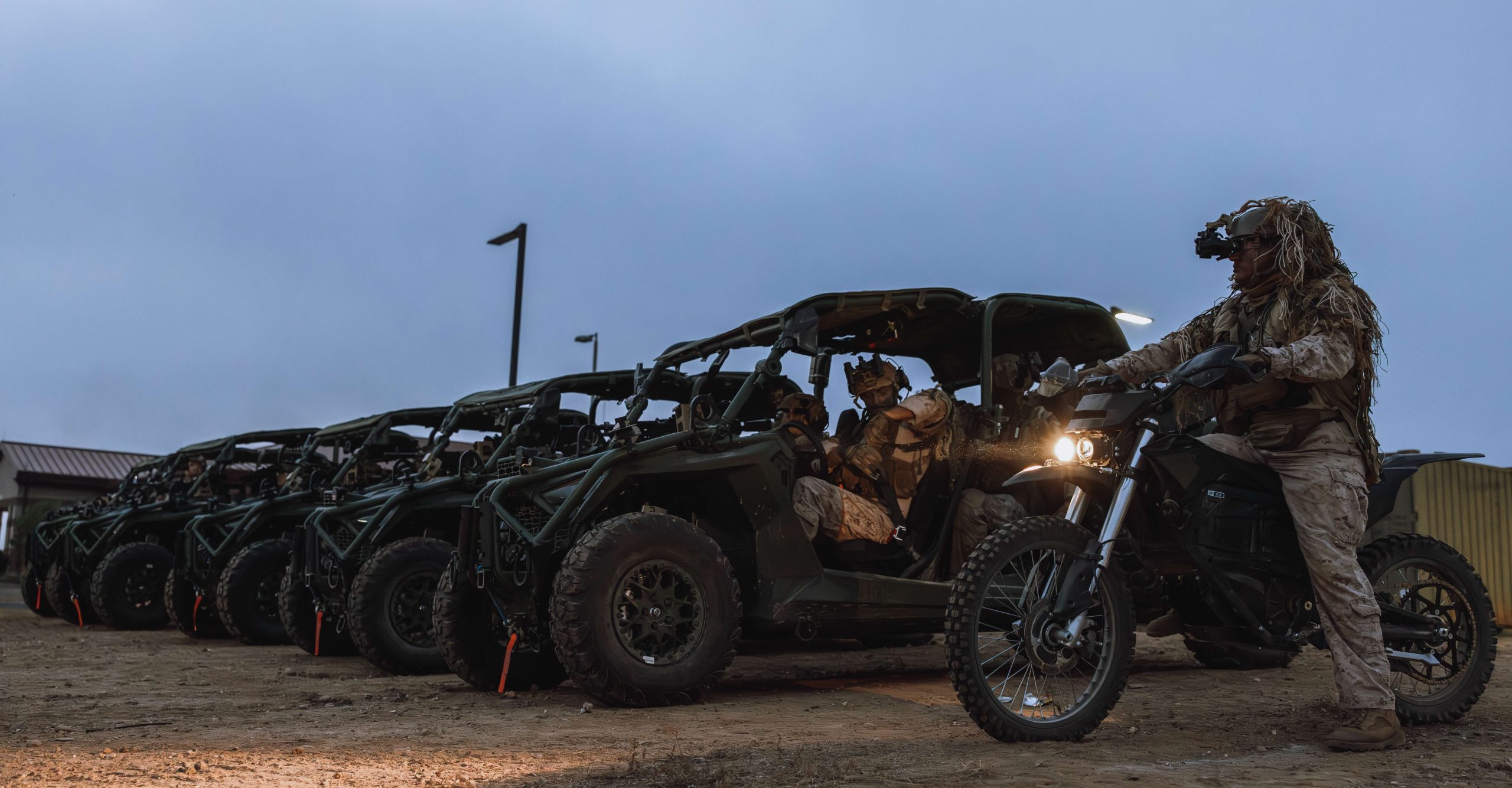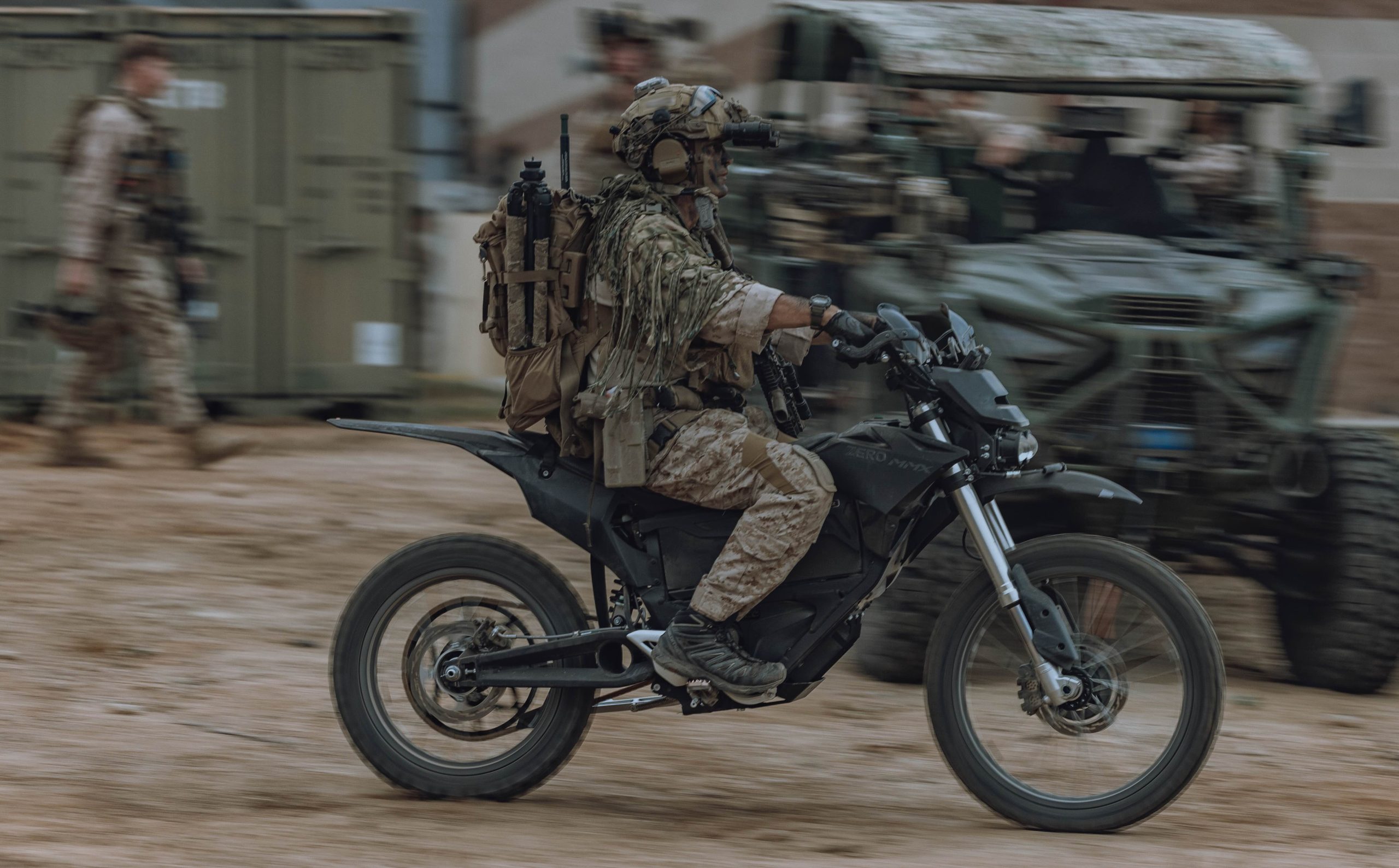
CAMP PENDLETON, Calif. – For the past year, a Marine reconnaissance platoon has been testing an all-electric motorcycle that will help bolster its role as the eyes and ears of a Marine ground combat force in the expected future fight.
First Platoon of Bravo Company, 1st Reconnaissance Battalion, will have eight new battery-powered Zero MMX bikes in its combat kit when they go overseas next year on a scheduled shipboard deployment as part of the 15th Marine Expeditionary Unit.
“We’re going to be the first guys deploying with them,” 1st Platoon commander Capt. Thomas Zahn, who will lead the 15th MEU’s reconnaissance platoon, told USNI News.
Platoon members have been putting the off-road motorcycles through a climate ringer of sorts, training at Camp Pendleton, across the Mojave and Colorado deserts at Twentynine Palms, Calif., and Yuma, Ariz., and even in the cooler, damp environments of Washington and Alaska. That’s bound to continue once overseas. “In the Philippines, we’ll test them in the super-wet jungle environment,” Zahn said. If the 15th MEU is sent to the U.S. 5th Fleet region, “it’ll be more of an airy desert – dry and hot.”
When paired with the platoon’s new ultralight tactical vehicles (ULTVs), the Zero MMX will further stretch their ability to conduct ground and amphibious reconnaissance and surveillance missions, Marines say. It is seen as a fitting complement to the Polaris MRZR Alpha, the ultralight tactical vehicle that will replace the Marine Corps’ utility task vehicles. The first ULTVs are being fielded to I Marine Expeditionary Force.
For Recon, the MMX “can fill a pretty good gap for us, in terms of doing ground reconnaissance,” said Cpl. Hollis Balenger. “We have a mobility team and we go and conduct patrols in the MRZRs. We stage those, cache them somewhere and push out on foot. Now what we can do is we have an even greater offset to whatever our objective is, push out a small element of dudes on a dirt bike and then cache the dirt bikes and go on foot, getting even closer.”
In a combat situation, two Recon Marines could cover a lot of ground and with a lower signature than “four trucks in a convoy or two trucks,” said Sgt. Santino Simolo. “That’s huge.”
The MMX is lightweight and agile – more akin to a Motocross dirt bike than a street-legal motorcycle and better able to withstand rough handling and rugged terrain. What makes it stand apart is its power source: Two Z-Force lithium-ion batteries power the bike’s electric drivetrain.
Military forces including the Marine Corps have used motorized bikes in some form since they were popularized as cheap personalized transport more than a century ago. During World War I, the Harley-Davidson “J” model was a ride of choice for the U.S. Army, coming on the heels of the motorcycle’s ease of use during Army Gen. George Pershing force’s earlier chase of Pancho Villa through rugged Mexico. Thousands were deployed for World War II.
Since then, the U.S. armed services have used motorcycles – until now, all gas-powered bikes – in some form in combat including in Afghanistan and at home for various missions such as scouting, airfield operations and base security. Modern electric motorcycles have been around since 2006, with California-based Zero Motorcycles leading the trend.
“The Zero MMX has proven that there is a role in the military for electric vehicles. It, along with a few remote-control vehicles for subterrain operations, have proven that they have the range and reliability required to conduct current missions,” Mike Jackson, the owner and president of MacGyver Solutions, Inc., told USNI.
“With an operational range of over 50 miles in an off-road environment, the Zero MMX is an excellent platform for reconnaissance and sniper teams to infiltrate, conduct its mission and exfil with silence, speed and low signature,” said Jackson, a former Army Green Beret.
The N.C.-based company has provided new equipment training, driver safety training and land navigation exercises to units receiving the MMX, as well as follow-up maintenance training. Other units with MMX motorcycles include 1st Light Armored Reconnaissance Battalion (LAR) at Camp Pendleton and 3rd LAR, which is based at the Marine Corps Air Ground Combat Center at Twentynine Palms, Calif., according to Bravo Company.
The MMX’s two 3.6-kw batteries allow the operator to travel on one battery for a lighter vehicle or two batteries for longer range, and they can “hot-swap” batteries with a support vehicle for sustained operations, according to MacGyver. While training with LAR units, the Recon Marines recharged their Zero batteries in the field using the light-armored vehicles. The company has developed a solar panel system as another charging option that has been used by U.S. special operations forces, but has not yet been evaluated by the Marine Corps, Jackson said.
Missions Envisioned

Recon Marines see many ways MMX in helping them support the 1st Marine Division. “We’ve been using them for whatever we can, for whatever mission we can,” said Capt. John Bender, Bravo Company commander. The company has 16 bikes so far. MMX operators have gotten certified and completed several courses to learn how to operate and handle the bikes in tactical situations and various terrain.
“The battalion’s stance was yes, we want to use these things and continue to use them. So we’re working to procure additional ones,” Bender said. “We have ones we’re testing [in] the courses that the guys go through, we have ones where the companies can use them, and we have a deployment set as well.”
“The battalion is definitely interested in procuring more, and they’re actively working through that right now,” he said. “In the future fight,” he added, “we’ll not be able to get JLTVs (joint light tactical vehicles) where you want them to go. Something smaller, more agile – yea, you can use that.”
The MMX’s light weight and footprint make it easy to transport. The Recon Marines fashioned mounting brackets on the front of the MRZR to carry the bike, Balenger said. “We were running in tandem with the Razors, so you could pop the bikes off the Razors and go and deploy them, and go and conduct scouting and stuff for a route that we’re doing, if there’s a large danger area that we’re running into.”
An MMX alone, in pairs or partnered with the larger ULTV can work well for satellite patrols.
“You have your patrol base, which has all the parts, the batteries and all that stuff, and from there you could like go on little scouting adventures and kind of do your own thing,” Simolo said. “Or, as your convoy is going, dirt bikes can kind of scout ahead and hold down positions, hold down roads, and if they see an issue, they can come back before … the whole convoy rolls down.” It can be used for blocking positions, direct action or other missions or work independently, perhaps as a communications relay, he said.
The electric bike might provide an advantage in places like the jungle environment, where it is hard to pierce through the thick canopy – whether with aircraft or small unmanned aerial systems – to identify routes or enemy movement or even to support logistics and resupply.
“You might be able to fly any type of class sUAS, but you might not be able to actually see what’s underneath there,” said Zahn, whose platoon will take eight newer Gen-2 MMX bikes on the 15th MEU deployment. “And it’s less a risk to the force to send a two- to four-man element.”
“It’s also good for overwatch positions,” he said. While training at Twentynine Palms, they pushed across the desert to “clear a route visually at a distance with a radio and call back, ‘you guys are clear from here.’” One idea, he added, is the “scout leader” concept that would employ the MMX forward in two-man elements, perhaps with snipers or a joint terminal attack controller (JTAC) to control fires.
Electric Pros and Cons

A pair of Zero lithium-ion batteries powers the electric drive. The maximum per-charge mileage depends on the driving style and environment. “It’s entirely terrain dependent and how fast you’re riding,” Balenger said. With new batteries, “you can easily squeeze 80-plus miles, give or take about five or ten” in milder terrain. The older batteries provide 60 to 70 miles each, he said, but pushing it hard “you can get as low as 30 miles.”
“We’ve killed bikes in like 20 minutes or so,” noted Simolo.
Operator weight is another factor in battery drain. While Motocross racers ride with minimal gear, Recon Marines are “wearing gear and guns and all this shit, so you’re always heavier,” Simolo said. “Motocross riders are like 130 pounds … A lot of dudes here are bigger and they have all this gear, so you kill the battery pretty good, pretty easily. That’s a downside to these bikes.”
“But for what they are, for out of the box,” he added, “they’re not that bad.”
With electric bikes, there are no gears to worry about, no clutch or kick-starter to engage. The Zero battery pack is tucked under the seat, which puts the weight a bit higher than a gas-powered bike and gives the 275-pound bike a heavier feel, he said.
“There’s no clutch – that’s a huge thing,” Simolo said. “The maintenance on it is less,” he added, “making sure that batteries are charged and having a way to charge it. It’s really just changing the lube chain oil, washing the bike, and changing the tires and parts that degrade with wear.”
Unlike gas-powered bikes, the electric motorcycle starts quickly, is much quieter and delivers instant power and speed that takes some adjusting. “You can’t control the amount of torque that’s getting delivered. It’s pretty much all or nothing,” Balenger said. “That was a huge thing for those of us who had ridden gas bikes.”
The MMX is not without faults, Marines have found. The front suspension needs a redesign, perhaps a bigger fork. If you drop the bike or crash it, Balenger said, “it’ll completely cut the engine,” requiring hitting a switch to cycle power back on. “I’d just want to get on the bike and ride away,” said Simolo. “To me, that’s one of the benefits of having an electric bike.” Another complaint: The main LED display shuts off when the running lights are off – a problem when it’s night and you’re in the middle of an reconnaissance and surveillance mission and you need to see how much battery remains.
Another downside, said Simolo, “is I can’t just pull over and put gas in the bike, so you need to think of ways to charge it or swap batteries. But, they don’t carry as much heat, they don’t get as hot” as gas-powered bikes. And that’s key when low signature is critical to avoid getting spotted by enemy forces. The MMX bikes “still get warm, and they’ll glow in a thermal optic, but not as bad,” he said.
“You could lay the bike down in the grass or in the bush, and it’s not going to start a fire from the exhaust and leak gas or whatever. You can pick it right back up and it’s ready to go,” Simolo added. “There’s no, I flooded the carburetor or whatever it is. It’s pretty cool, because with dirt bikes, if you’re going through tall grass, you have to be worried about starting fires and all that jazz. There’s no consideration for that. You can just push wherever you want. It gets warm, but not hot enough to start a fire.”
Logistics Considerations

Operator-level maintenance is easy, the Marine Corps said. “We’ve had a good amount of reps doing that as well, replacing tires, rims … a couple of chains,” Balenger said. “We’ve had to tighten or tension the chains down, too.”
An MRZR or ULTV “can be a support vehicle and hold spare parts,” Simolo said. “But if you’re going out on longer rides with just the bikes, one of us has a tool kit, someone else has tubes or patch kits. That’s kind of all you need. Zip ties, hose clamps, a kit we’ve built over time.”
During training events, Bravo Company inserted the MMX bikes in tandem with the MRZRs via Marine Corps CH-53E heavy-lift helicopters and MV-22 Osprey tiltrotor aircraft, as well as Army CH-47 Chinook transport helicopters. That hasn’t yet been done with the ULTVs, however, as “they’re still in the testing phase,” Zahn said. The ULTVs are a little longer and a little taller than the existing MRZRs, he said, but “we will test them before we deploy.”
One key milestone came when the MMX was air-dropped from a C-130 Hercules transport aircraft near Yuma using the Joint Precision Airdrop Delivery System. It was a big deal, Bender said, “validating that we can actually insert these things … to do reconnaissance or some type of direct-action raid. That we can actually get them into where we need them to go was huge.”
What’s Ahead

This fall, Bravo Company and the rest of the 15th MEU – a Marine air-ground task force that includes Battalion Landing Team 1/5, Combat Logistics Battalion 15 and Marine Medium Tiltrotor Squadron 165 (Reinforced) – is compositing with Amphibious Squadron 5 and the USS Boxer Amphibious Ready Group.
The electric motorcycles and ULTVs will be new additions that will require some initial adjustments to logistical considerations for the MAGTF’s aircrews and the Navy’s amphibious ships, the Marines Corps says. The MMX hasn’t been out to sea just yet.
“It’s just working through the other parts of the MAGTF… so how we’re loading it makes tactical sense,” Zahn said. “It’s a tactical on-load, so when they land on the deck, it’s ready to go. The operators can be in their vehicles, executing the mission without pause, and it doesn’t delay aircraft getting off the deck. We want to make sure we have the solution with the ULTV, so it’s not an administrative cargo drop. It’s like a tactical insert.”
At sea, the Recon Marines will face similar concerns of corrosion to the bikes and batteries. Its lithium-ion batteries can pose a huge hazmat issue, Balenger said, but “we’ll probably be figuring that out soon.”
Their initiative pitched to the division is now including Charlie Company following a successful first field test last year, when a dozen Recon Marines and two MMX bikes along with four MRZRs and a seven-ton support vehicle spent a couple of weeks at the Twentynine Palms desert base. “The whole thing was self-sustaining by us. We didn’t have anybody dropping fuel for us,” Balenger said. They pushed out from Camp Wilson “with what we had.”
“It was to see how long we can sustain if it was just us,” said Simolo. “We just kind of did our own thing, whether it was food, guns, ammo. Any kind of sustainment was just off the vehicles. That was pretty successful.” They soon learned the benefits of operating an off-road vehicle like a dirt bike whenever the other tactical vehicles got stuck. “We’d change the route to accommodate them,” he said.
Bravo Company and 1st Recon Battalion are continuing to develop the program and figuring out how to operate and employ the electric bikes “as safely and as efficiently as possible,” Zahn said. Recon Marines hope to see the MMX become a program of record. It’s not there just yet. “This whole program is incredibly young,” Balenger said. “It’s exciting to see where it is going to go from here.”





